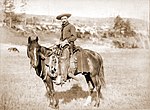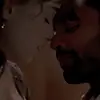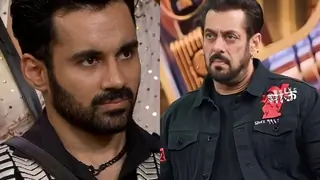Hat[edit source]

Lawman Bat Mastersonwearing a bowler hat
In the early days of the Old West it was the bowler hat rather than the slouch hat, centercrease (derived from the army regulation Hardee hat), or sombrero that was the most popular among cowboys as it was less likely to blow off in the wind.[1] By the 1870s, however, the Stetson had become the most popular cowboy hat due to its use by the Union Cavalry as an alternative to the regulation blue kepi.[2][3]
Stampede strings were installed to prevent the hat from being blown off when riding at speed. These long strings were usually made from leather or horsehair.[4] Typically, the string was run half-way around the crown of a cowboy hat, and then through a hole on each side with its ends knotted and then secured under the chin or around the back of the head keeping the hat in place in windy conditions or when riding a horse.
The tall white Ten gallon hats traditionally worn by movie cowboys were of little use for the historical gunslinger as they made him an easy target, hence the preference of lawmen like Wild Bill Hickok, Wyatt Earp and Bat Masterson for low-crowned black hats.[5]
Originally part of the traditional Plains Indian costume, coonskin caps were frequently worn by Mountain men like Davy Crockett for their warmth and durability. These were revived in the 1950s following the release of a popular Disney movie starring Fess Parker.[6][7]
Shirt[edit source]
1950s style Western shirt with snap fastenings of the type popularised by singing cowboys
A Western shirt is a traditional item of Western Wear characterized by a stylized yoke on the front and on the back. It is generally constructed of denim or tartan fabric with long sleeves, and in modern form is sometimes seen with snap pockets, patches made from bandana fabric, and fringe.
A Western dress shirt is often elaborately decorated with piping, embroidered roses and a contrasting yoke. In the 1950s these were frequently worn by movie cowboys like Roy Rogers or Clayton Moore's Lone Ranger.[8] Derived from the elaborate Mexican vaquero costumes like the Guayabera and the battleshirts worn by many Confederate soldiers, these were worn at rodeos so the cowboy could be easily identifiable.[9] Buffalo Bill was known to wear them with a buckskin fringe jacket during his Wild West shows and they were fashionable for teenagers in the 1970s and late 2000s.
Another common type of Western shirt is the shield-front shirt worn by many US Cavalry troopers during the American Civil War but originally derived from a red shirt issued to prewar firefighters. The cavalry shirt was made of blue wool with yellow piping and brass buttons and was invented by the flamboyant George Armstrong Custer.[10] In recent times this shield-front shirt was popularised by John Wayne in Fort Apache and was also worn by rockabilly musicians like the Stray Cats.
Coat[edit source]

Fringe jacket

the late Larry Hagman asJ.R. Ewing wearing a business suit with Western detailing
When a jacket is required there is a wide choice available for both linedancers andhistorical re-enactors. These include frock coats, ponchos popularised by Clint Eastwood's Spaghetti Westerns, short Mexican jackets with silver embroidery, fringe jackets popular among outlaw country, southern rock and 1980s heavy metal bands,[11]and Duster coats derived from originals worn in the Wild West.[12] More modern interpretations include leather waistcoats inspired by the biker subculture and jackets with a design imitating the piebald color of a cow. Women may wear bolero jackets derived from the Civil War era zouave uniforms, shawls, denim jackets in a color matching their jeans or skirt, or a fringe jacket like Annie Oakley.[13]
For more formal occasions inhabitants of the West might opt for a suit with "smile" pockets, a half-belt at the rear, piping and a yoke similar to that on the Western shirts. This can take the form of an Ike jacket, Leisure suit or three-button sportcoat. Country and Western singer Johnny Cash was known to wear an all-black Western suit, in contrast to the elaborate Nudie suits worn by stars like Elvis and Porter Waggoner.[14] The most elaborate western wear is the custom work created by rodeo tailors such as Nudie Cohn and Manuel, which is characterized by elaborateembroidery and rhinestone decoration. (See also Nudie suit.) This type of western wear, popularized by country musicperformers, is the origin of the phrase rhinestone cowboy.
Trousers[edit source]

Cowboy wearing leatherchaps at a rodeo
In the early days of the Wild West trousers (US English: pants) were made out of wool. In summer canvas was sometimes used. This changed during the Gold Rush of the 1840s when denim overalls became popular among miners for their cheapness and breathability. Levi Strauss improved the design by adding copper rivets[15] and by the 1870s this design was adopted by ranchers and cowboys.[16] The original Levi's jeans were soon followed by other makers including Wrangler jeans[17] and Lee Cooper. These were frequently accessorised with kippy belts featuring metalconchos and large belt buckles
Leather chaps were often worn to protect the cowboy's legs from cactus spines and prevent the fabric from wearing out.[18] Two common types include the skintight shotgun chaps[19] and wide batwing chaps. The latter were sometimes made from hides retaining their hair (known as "woolies") rather than tanned leather. They appeared on the Great Plains somewhere around 1887.[20]
Women wore knee-length prairie skirts,[21] red or blue gingham dresses or suede fringed skirts derived from Native American dress. Saloon girls wore short red dresses with corsets, garter belts and stockings.[22] After World War II, many women, returning to the home after working in the fields or factories while the men were overseas, began to wear jeans like the men.
Neckwear[edit source]

Working cowboy wearing a bandana or "wild rag," 1880s
During the Victorian era, gentlemen would wear silk cravats or neckties to add color to their otherwise sober black or grey attire. These continued to be worn by respectable Westerners until the early 20th century. Following the Civil War it became common practise among working class veterans to loosely tie a bandana around their necks to absorb sweat and keep the dust out of their faces. This practise originated in the Mexican War era regular army when troops threw away the hated leather stocks (a type of collar issued to soldiers) and replaced them with cheap paisley kerchiefs.[23]
Another well-known Western accessory, the bolo tie, was a pioneer invention reputedly made from an expensive hatband.[24] This was a favorite for gamblers and was quickly adopted by Mexican charros, together with the slim "Kentucky" style bowtie commonly seen on stereotypical Southern gentlemen like Colonel Sanders[25] or Boss Hogg. In modern times it serves as formal wear in many western states, notably Montana, New Mexico[26] and Texas.[27]
Footwear[edit source]
See Cowboy Boot





























